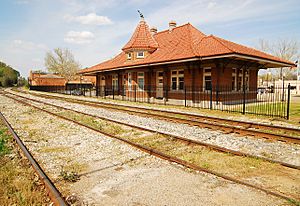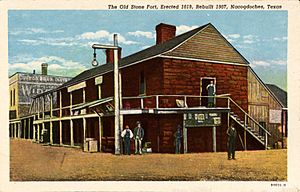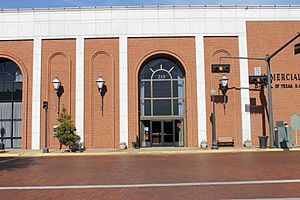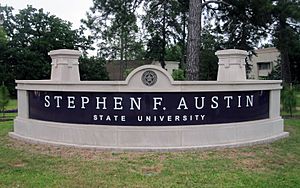Nacogdoches, Texas facts for kids
Quick facts for kids
Nacogdoches, Texas
|
||
|---|---|---|
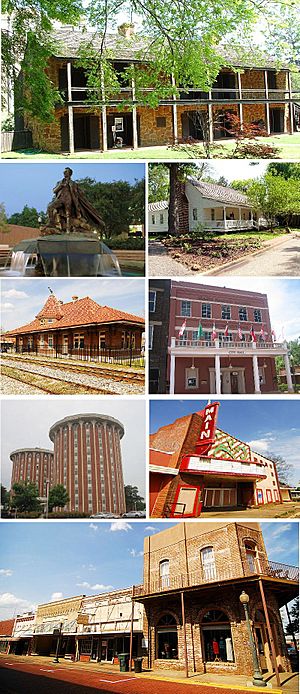
Clockwise from top: Old Stone Fort, Adolph Stern House, Nacogdoches City Hall, Nacogdoches downtown, Gladys E. Steen Dorms, Depot, Stephen F. Austin statue
|
||
|
||
| Nickname(s):
"The Oldest Town in Texas"
|
||
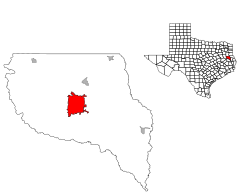
Location of Nacogdoches, Texas within Nacogdoches County
|
||
| Country | ||
| State | ||
| County | Nacogdoches | |
| Incorporated (as a town) | 1837 | |
| Incorporated (as a city) | 1929 | |
| Government | ||
| • Type | Council-Manager | |
| Area | ||
| • Total | 27.66 sq mi (71.64 km2) | |
| • Land | 27.61 sq mi (71.51 km2) | |
| • Water | 0.05 sq mi (0.13 km2) | |
| Elevation | 331 ft (101 m) | |
| Population
(2020)
|
||
| • Total | 32,147 | |
| • Density | 1,190.81/sq mi (459.78/km2) | |
| Demonym(s) | Nacogdochian | |
| Time zone | UTC-6 (Central (CST)) | |
| • Summer (DST) | UTC-5 (CDT) | |
| ZIP Codes |
75961–75965
|
|
| Area code(s) | 936 | |
| FIPS code | 48-50256 | |
| GNIS feature ID | 2411207 | |
Nacogdoches (![]() i/ˌnækəˈdoʊtʃɪs/ NAK-ə-DOH-chis) is a city in East Texas, United States. It is the main city of Nacogdoches County. In 2020, about 32,147 people lived there.
i/ˌnækəˈdoʊtʃɪs/ NAK-ə-DOH-chis) is a city in East Texas, United States. It is the main city of Nacogdoches County. In 2020, about 32,147 people lived there.
Nacogdoches is often called "The Oldest Town in Texas." It is also home to Stephen F. Austin State University, which is known for its programs in forestry and agriculture.
Contents
A Look at Nacogdoches History
Early Settlements in Nacogdoches
Nacogdoches is known as "the oldest town in Texas." People have lived in this area for a very long time, possibly as far back as 10,000 years ago. It was once the main village of the Nacogdoche tribe, who were part of the Caddo Indian group.
The area remained a Caddo Indian settlement until the early 1800s. In 1716, Spain built a mission here called Nuestra Señora de Guadalupe de los Nacogdoches. This was the first European building in the area.
After the French left the region in the 1760s, Spanish officials decided the mission was too expensive. In 1772, they told all settlers to move to San Antonio. Some people were happy to leave, but others had to be forced out by soldiers.

A Spanish trader named Colonel Antonio Gil Y'Barbo became a leader for the settlers. In 1779, he led a group back to Nacogdoches. That summer, Spain officially named Nacogdoches a pueblo, or town. This made it the first "town" in Texas. Y'Barbo set up the rules for the local government. He planned the streets around the El Camino Real (now State Highway 21) and La Calle del Norte/North Street (now Business U.S. Highway 59-F). He also built a stone house for his trading business, which is now known as the Old Stone Fort. It was an important gateway between the United States and the Texas frontier.
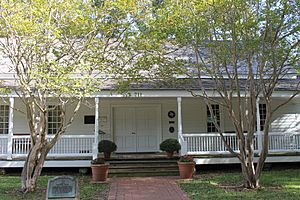
Nacogdoches in the 1800s
Nacogdoches has been under more flags than the state of Texas! Besides the Six Flags (Spain, France, Mexico, Republic of Texas, United States, Confederacy), it also flew under the flags of the Magee-Gutierrez Republic, the Long Republic, and the Fredonian Rebellion.
In 1820, people from the United States started moving to Nacogdoches. The first English-language newspaper in Texas was printed here. However, the very first newspaper in the 1700s was in Spanish. An old Spanish edition is kept at the local museum.
In 1832, the battle of Nacogdoches happened. Many local settlers joined together to support a federalist government. They successfully drove the Mexican military out of East Texas.
Thomas Jefferson Rusk was an important early settler in Nacogdoches. He was a hero of the Texas Revolution and signed the Texas Declaration of Independence. He also served as a U.S. Senator for Texas. He helped start Nacogdoches University, which was open from 1845 to 1895. The Old Nacogdoches University Building is now a historic landmark.
Sam Houston, another famous figure, lived in Nacogdoches for four years before the Texas Revolution in 1836. He even had a law office downtown.
William Goins, who was of mixed race, ran a local inn, a trucking service, and a blacksmith shop. He also owned a plantation outside Nacogdoches. He helped the Texas Army during the Revolution.
Adolphus Sterne was a merchant who had the nicest home in town. Famous people like Sam Houston and David Crockett often visited him. His diary is a great source of information about early Nacogdoches history.
The August Tubbe Plantation is one of the last family-owned plantations in East Texas. It was started in 1859 by August Tubbe, an immigrant from Germany. The plantation grew cotton and sugarcane, and later became important for lumber production. The Tubbe Sawmill was the first water-powered, then steam-powered, sawmill in Nacogdoches. The Tubbe family is considered one of the "founding families" of Nacogdoches.
In 1859, the first oil well in Texas started working near Nacogdoches. It was drilled by Lyne Taliaferro Barret. He struck oil in 1866, but the project stopped because oil prices dropped. The site was not as famous as Spindletop, but it is still known as the first and oldest oil well in Texas.
Nacogdoches from the 1900s to Today
In 1912, the Marx Brothers performed their singing act at the old Opera House in Nacogdoches. There's a historic plaque downtown to remember this event.
John Wayne even mentioned the town in some of his movies, like Big Jake.
In 1997, singer Willie Nelson came to Nacogdoches to perform with his friend, Paul Buskirk. While he was here, Nelson recorded some jazz songs. In 2004, he released these songs on an album called Nacogdoches.
On February 1, 2003, the Space Shuttle Columbia broke apart when it returned to Earth. Many pieces of the shuttle landed in the Nacogdoches area. News reports about finding the debris often focused on Nacogdoches.
In 2005, Hurricane Rita hit Nacogdoches as a Category 1 hurricane. Many people from Houston and Galveston evacuated to Nacogdoches, causing long lines at gas stations and shortages of food and fuel. Because of this, U.S. Highway 59 (which will become Interstate 69) is now an evacuation route. All its lanes can be used for traffic going one way during an evacuation.
In 2008, Hurricane Ike also hit Nacogdoches as a Category 1 hurricane.
Nacogdoches hosts the Texas Blueberry Festival every year in June. The county produces the most blueberries in Texas! The city is also called the "Capital of the Texas Forest Country." It is known as a friendly town and has won awards for its historic downtown.
Nacogdoches is the main office for the Texas Wing of the Civil Air Patrol. This group helps with emergency services, like search and rescue, and offers aerospace education and programs for teenagers.
Nacogdoches Geography
Nacogdoches is located at 31°36′32″N 94°39′3″W / 31.60889°N 94.65083°W. It is about 140 miles (225 km) northeast of Houston, 180 miles (290 km) southeast of Dallas, and 90 miles (145 km) southwest of Shreveport.
The city covers about 25.3 square miles (65.5 km2). Most of this area is land, with a small amount of water. The city center is just north of where two creeks, the LaNana and Banita, meet.
Lake Nacogdoches is located about 10 miles (16 km) west of the city.
Nacogdoches Climate
| Weather chart for Nacogdoches, Texas | |||||||||||||||||||||||||||||||||||||||||||||||
|---|---|---|---|---|---|---|---|---|---|---|---|---|---|---|---|---|---|---|---|---|---|---|---|---|---|---|---|---|---|---|---|---|---|---|---|---|---|---|---|---|---|---|---|---|---|---|---|
| J | F | M | A | M | J | J | A | S | O | N | D | ||||||||||||||||||||||||||||||||||||
|
4.4
57
36
|
3.9
62
40
|
4.2
69
47
|
4.1
76
55
|
4.8
83
64
|
4.1
90
71
|
2.9
93
74
|
3.1
94
73
|
3.7
88
67
|
4
79
56
|
4.6
68
45
|
4.6
59
38
|
||||||||||||||||||||||||||||||||||||
| temperatures in °F precipitation totals in inches source: Weather.com / NWS |
|||||||||||||||||||||||||||||||||||||||||||||||
|
Metric conversion
|
|||||||||||||||||||||||||||||||||||||||||||||||
- The warmest month on average is August.
- The highest temperature ever recorded was 112°F (44°C) in 2000.
- The coolest month on average is January.
- The lowest temperature ever recorded was 3°F (-16°C) in 1989.
- May usually has the most rain.
People of Nacogdoches
| Historical population | |||
|---|---|---|---|
| Census | Pop. | %± | |
| 1850 | 468 | — | |
| 1860 | 485 | 3.6% | |
| 1870 | 500 | 3.1% | |
| 1880 | 333 | −33.4% | |
| 1890 | 1,138 | 241.7% | |
| 1900 | 1,827 | 60.5% | |
| 1910 | 3,369 | 84.4% | |
| 1920 | 3,546 | 5.3% | |
| 1930 | 5,687 | 60.4% | |
| 1940 | 7,538 | 32.5% | |
| 1950 | 12,327 | 63.5% | |
| 1960 | 12,674 | 2.8% | |
| 1970 | 22,544 | 77.9% | |
| 1980 | 27,149 | 20.4% | |
| 1990 | 30,872 | 13.7% | |
| 2000 | 29,914 | −3.1% | |
| 2010 | 32,996 | 10.3% | |
| 2020 | 32,147 | −2.6% | |
| U.S. Decennial Census | |||
In 2020, Nacogdoches had a population of 32,147 people. The city is home to a diverse group of residents.
| Race | Number | Percentage |
|---|---|---|
| White (NH) | 15,446 | 48.05% |
| Black or African American (NH) | 8,376 | 26.06% |
| Native American or Alaska Native (NH) | 96 | 0.3% |
| Asian (NH) | 543 | 1.69% |
| Pacific Islander (NH) | 3 | 0.01% |
| Some Other Race (NH) | 122 | 0.38% |
| Mixed/Multi-Racial (NH) | 1,061 | 3.3% |
| Hispanic or Latino | 6,500 | 20.22% |
| Total | 32,147 |
In 2019, the average family size was about 3 people. The median age in Nacogdoches was 24.4 years old.
The average household income in the city was $54,444 from 2014 to 2019. About 31% of the city's population lived at or below the poverty line.
Nacogdoches Economy
The economy of Nacogdoches relies a lot on Stephen F. Austin State University. Like many college towns, local businesses depend on students as customers and often hire them for jobs. Other important parts of the local economy include healthcare, manufacturing, farming, and lumber.
Here are some of the top employers in Nacogdoches:
| # | Employer | Employees 2017 |
|---|---|---|
| 1 | Stephen F. Austin State University | 1,659 |
| 2 | Pilgrim's Pride | 1,657 |
| 3 | Nacogdoches Independent School District | 972 |
| 4 | Nacogdoches County Hospital District | 874 |
| 5 | Etech, Inc. | 565 |
| 6 | Nacogdoches Medical Center | 545 |
| 7 | Walmart | 473 |
| 8 | City of Nacogdoches | 323 |
| 9 | Nacogdoches County | 275 |
| 10 | Eaton (Cooper Power Systems) | 257 |
Education in Nacogdoches
Most of the city of Nacogdoches is served by the Nacogdoches Independent School District. Some small parts of the city are in the Woden ISD. Other school districts nearby include Central Heights, Douglass, Garrison, Martinsville, Chireno, and Cushing.
Nacogdoches is home to Stephen F. Austin State University. This is a state university with about 13,000 students. Angelina College also has a branch campus in Nacogdoches.
Local Newspaper
The Daily Sentinel is a newspaper that has been published in Nacogdoches since 1899.
Places to Visit in Nacogdoches
- Mast Arboretum
- Millard's Crossing Historic Village
- Old Stone Fort Museum
Famous People from Nacogdoches
- Oscar P. Austin, a Medal of Honor winner
- Roy Blake, Sr., Texas politician and businessman
- Antonio Gil Y'Barbo, a frontier trader
- Sam Houston, president of the Republic of Texas
- Kay Bailey Hutchison, a U.S. Senator
- Joseph W. Kennedy, who helped discover plutonium
- Joe R. Lansdale, a famous author
- Leslie Ludy, author and speaker
- Thomas Jefferson Rusk, military leader and U.S. Senator
- Cornelia Branch Stone, president of the United Daughters of the Confederacy
- Albert Thomas, U.S. Representative
- Lera Millard Thomas, U.S. Representative
Athletes
- Grady Allen, football player
- Brandon Belt, baseball player
- Bucky Brandon, baseball player
- Domingo Bryant, football player
- Larry Centers, football player
- Clint Dempsey, soccer player
- Philip Humber, baseball player
- Damion James, basketball player
- Mark Moseley, football player
- Bum Phillips, football coach
- Greg Roberts, football player
- Jeremiah Trotter, football player
- Thomas Walkup, basketball player
- Grayson Rodriguez, baseball player
- Brandon Jones (safety), football player
- Jaxon Smith-Njigba, football player
Entertainers
- Tony Frank, actor
- Kasey Lansdale, actress and musician
- Bob Luman, musician
- Brad Maule, actor
- Ron Raines, actor
- Alana Stewart, actress, talk show host
- Joseph Fuller, musician
See also
 In Spanish: Nacogdoches para niños
In Spanish: Nacogdoches para niños


